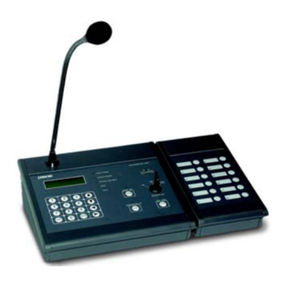
Ref. 11/676 PM2092/2-V
PMS2000 System2
1. DESCRIZIONE GENERALE
La scheda di controllo PM2092/2-V è stata creata
per consentire l’esecuzione semplice e veloce di
test sugli amplificatori modulari PMWxx1e per
verificare l’integrità della/e linea/e altoparlanti
tramite l’utilizzo delle schede PM2094-V. Questa
scheda è inoltre in grado di verificare un’eventuale
cortocircuito presente su una delle due uscite. La
verifica può essere effettuata in due modalità: a
comando da seriale oppure in modo automatico se
sono presenti musica di sottofondo o annunci. Nel
caso in cui venga riconosciuto in una delle 2 uscite
un corto-circuito, automaticamente questa linea
viene sconnessa per fare in modo che l’altra linea
possa continuare a funzionare regolarmente. La
scheda gestisce tutte le funzioni dell’amplificatore,
dagli ingressi alla diagnostica ed è in grado di
eseguire le seguenti funzioni:
• misure di impedenza di linea;
• diagnostica dell’amplificatore;
• verifica dell’integrità della linea altoparlanti
(PM2094-V).
• verifica isolamento di terra (GND FAULT);
• controllo di volume;
• selezione di due ingressi;
• controllo relè segnalazione guasti;
• possibilità di inserimento del filtro LOW CUT;
• funzionamento in modalità di risparmio
energetico ‘LOW POWER’.
La scheda può inoltre essere controllata tramite
interfaccia seriale. Oltre ad eseguire tutte le
operazioni e/o verifiche impostate localmente
con i dip-switches, sarà possibile visualizzare e
modificare tutti i parametri tra cui:
• lettura dell’impedenza di riferimento per il
test;
• valore minimo e massimo entro cui il test
risulta valido;
• lettura dello stato dei test;
• test dell’ingresso;
• misura della temperatura dei transistor finali;
• regolazione del volume;
• comando remoto del relè test.
1. DESCRIZIONE GENERALE
The PM2092/2-V control card was created to
provide a simple and rapid way of testing the
PMWxx1modular amplifiers and for checking
the integrity of the loudspeaker line(s) using the
PM2094-V cards.
This card is also capable of investigating a possible
short circuit on one of the two outputs. This can
be done in either of two ways: controlled via a
serial connection or automatic, if background
music or announcements are present. If a short
circuit is recognised on one of the 2 outputs, this
line will be automatically disconnected so as to
enable the other line to continue working properly.
This card manages all the functions of the
amplifier, from the inputs to diagnostics, and is
capable of carrying out the following functions:
• line impedance measurements;
• amplifier diagnostics;
• check of the integrity of the loudspeaker line
(PM2094-V).
• check of insulation to earth (GND FAULT);
• volume control;
• selection of two inputs;
• checking of fault-reporting relay;
• possibility of including the LOW CUT filter;
• operation in the ‘LOW POWER’ energy-saving
mode.
The card can also be controlled via a serial interface.
In addition to carrying out all the operations and/or
checks set locally by means of the dip switches,
it will also be possible to display and alter all the
parameters, including the following:
• reading of the reference impedance for the
test;
• minimum and maximum values between which
the test is valid;
• reading of the test status;
• testing of the input;
• measurement of the temperature of the end
transistors;
• volume adjustment;
• remote control of test relay.
(1)
Nel modello PMW500-V, la scheda è integrata all’interno
dell’apparecchio.
(1)
In the PMW500-V model, the card is built into the
equipment.





























